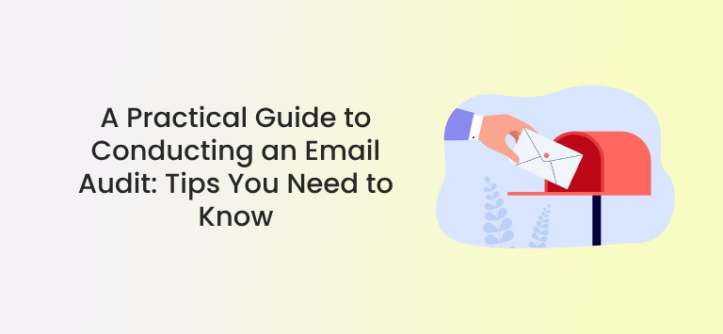Email marketing is a powerful tool that can have profound results when used correctly. However, trends are constantly changing, and to ensure that your marketing strategy is effective, it’s important to conduct regular audits.
These audits are designed to identify problem areas, what works, and elements that need improvement.
If you are hoping to learn more about email audits, then you have come to the right place. This article will provide a comprehensive guide on how to conduct such audits for the betterment of your marketing strategy and company as a whole.
What Is an Email Audit?
An email audit is essentially a report that offers a comprehensive assessment of the “health” of your existing email advertising campaign over a set period of time.
The goal of a good email audit is to make note of your company’s goals and objectives and determine the best way forward based on the information you have obtained. It also generates comprehensive analytics for marketers. This data can help them design and implement more effective email marketing campaigns.
An email audit can reveal flaws and errors in a campaign as well as the strengths of your company’s overall performance, allowing you to address issues and enhance future outcomes. It will also help you build more meaningful relationships with prospects and drive traffic to your website.
It’s important not to confuse email audits with email marketing. The latter is the process of sending emails to existing and prospective customers to promote a product, deal, or service, while audits take the metric data of a campaign and process it to identify possible flaws and areas that require improvement.
There are three main types of email audits. They are as follows:
- Strategic audits. Effective strategic email audits ensure consistency by assessing the alignment of email communication with a business’s goals.
- Compliance audits. These email audits ensure that legal and industry standards are adhered to, protecting the company against data breaches and ensuring proper data handling.
- Technical audits. To improve functionality, technical audits focus on email infrastructure, examining things like deliverability, the performance of the server, and data security.
Ideally, you want your email audit to combine these three types.
Step-by-step Guide to Conducting an Email Audit
Now that you have a good understanding of what email audits are and why they are used, it’s time to talk about how you can harness this powerful tool to make the most of your email marketing campaign.
Step One: Plan and Prepare
Like most things in life, it’s always good to go in with a plan. The truth is that email audits can be tedious and overwhelming, so it’s always good to start by breaking it down into clear and achievable steps.
In this step, you will need to choose the type of audit you’re conducting. You can go for one of the types mentioned above or use a combination.
Next, write down your goals for the project and what you hope to achieve. This will give you clear guidance on what to look for when conducting your audit. It’s also helpful to have your company goals on hand during this process and use them to define the objectives for the project.
Want to know more about the tools available for successful email marketing? Read the Top 9 Email Marketing Tools for Small Businesses.
Step Two: Gather the Necessary Data and Tools for Conducting the Audit
Once you have some direction, it’s time to gather the tools and data that you’ll need. You won’t need any fancy software for this. A simple spreadsheet will do. To set it up, here are a few headings you should consider adding:
- Campaign name
- Email Subject Line
- Target Audience
- Unsubscribe rate
- Click-through rate (CTR)
- Open rate
You can obtain this using data from marketing team members and your email marketing tool. Once this is done, collect the information and use it to populate your spreadsheet.
Step Three: Conduct the Email Audit
After categorizing the information in the spreadsheet, analyze it and compare it to industry benchmarks, the results of previous success rates, and campaign goals to determine whether your marketing strategy is successful.
This will help you see how your campaign compares to others like it and help you identify problem areas and things that are working well.
If you are conducting a technical audit, then you will need to look at things like authentication protocols, feedback loops, the SMTP server, and DNS records.
You should also look for changes in your subscriber list, customer engagement, sales figures, and more to understand how well the email marketing campaign has performed if you are conducting a strategic audit.
Be sure to compare this data with the company goals and expectations for the project.
Step Four: Identify Potential Compliance Issues and Legal Considerations
You will also need to check that your email marketing campaign complies with legal standards. This is an important part of the process, as it can help to prevent legal repercussions and protect the companies against unnecessary expenses that could arise because of non-compliance.
Don’t just look at the applicable laws and regulations, but also look at the terms and conditions of the service providers the company uses. Violating its rules could have serious consequences and have the company banned, so be sure to conduct a thorough investigation.
If you notice any potential issues, make a note of them so that you can include it in your report, which you will generate in the next step.
Step Five: Actionable Recommendations and Reporting
Once you have verified legal compliance, it’s time to take a close look at your data and really get into the heart of the matter. Examine all of the metrics and data you collected and identify campaigns that differ from industry standards due to significant differences in metrics.
Pose questions to determine whether the outcome of the campaign was positive or poor overall. Consider the various aspects such as the send time, subject line, and various other elements and determine which one can be held responsible for the campaign’s performance.
It’s important that you look at the emails and make a note of how they would appear to you if you were the end user.
Write down your findings and use them to create a report that includes your recommendations that the company can implement to address these issues and improve future campaigns.
Once you are confident that you have covered all the important aspects of the campaign, it’s time to refine your information into a presentation and/or report that you can prevent to stakeholders.
Step Six: Summarize Key Findings and Recommendations from the Email Audit
If you need to share your findings and recommendations with management or stakeholders, then be sure to prepare a summarized, well-rounded report that details your results. You can include graphs to make the report more engaging and prove your point.
It’s also a good idea to include a powerful presentation that you can use in the next step.
Step Seven: Present the Report to Stakeholders and Obtain Approval for Implementing the Recommendations
The final step is presenting your findings to management. Be sure to mention key metrics and how the campaign performed compared to past campaigns and industry standards. You will also need to highlight any compliance issues and make sure that you provide stakeholders with comprehensive solutions that will hold the company in good stead.
Final Thoughts
Well, there you have it! By following these steps, you can conduct a comprehensive email audit that helps you identify problem areas, compliance issues, and more. Using this information, you can better plan for future email marketing campaigns to ensure the company’s success.
If you are hoping to optimize your email marketing strategy and boost conversions for you site, then you need to try using Poptin to collect leads from your website with engaging popups, forms, and so much more.
Sign up for free, or get in touch with us to learn more!




